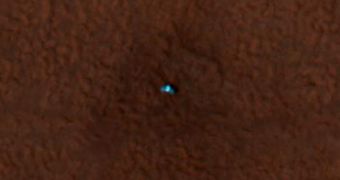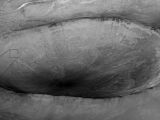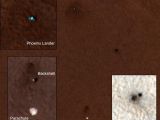It seems that NASA has hit the jackpot with the successful landing of the Phoenix Mars Lander on the Red Planet and is planning to make the best of it. After it revealed on Monday that the Mars Reconnaissance Orbiter was able to photograph the spacecraft while descending to the surface, NASA has now released an image taken by the same orbiter, allegedly showing the Phoenix Mars Lander resting safely in the northern plains of Mars.
The Phoenix spacecraft may be safe, but the radio of the Mars Reconnaissance Orbiter is not. For some unknown reason, the device shut itself down, thus preventing further data relaying from Earth to the lander. "Phoenix is healthy, everything is fine", said Fuk Li, manager of the Mars Exploration Laboratory at NASA's Jet Propulsion Laboratory.
The setback delayed the instructions that should have been sent to Phoenix yesterday morning as well as the relay of another set of images from the areas surrounding the spacecraft and of some of its instruments it is carrying. The problem should have been solved later that day, when the MRO passed again over the regions where Phoenix landed, but NASA still has to confirm the attempt.
Once radio communication is restored, mission controllers will give Phoenix the command to move its robotic arm, in preparation for the digging operations that are expected to begin next week, when it will also analyze the first samples dug up by the arm.
The upper color image was taken on Monday by the Mars Reconnaissance Orbiter's HiRISE camera and shows Phoenix along with its solar panel arrays on the surface of the planet. The backshell, the parachute and the heat shield of the lander are also visible in the picture, several hundred meters away from the spacecraft. "We're thrilled with these images", said HiRISE principal investigator Alfred McEwen from the University of Arizona. More images from orbit are expected as the Phoenix's mission unfolds.
Other images sent late on Monday show that the protective biobarrier of the robotic arm fully deployed and that Mars' sky is somehow clearer than estimated, as the lander was able to capture a series of hills located about 9 kilometers away from it. "That means that there's not much dust in the atmosphere; it's a very clear day", said Phoenix principal investigator Peter Smith from the University of Arizona.
Although the spacecraft landed slightly farther away from the originally designated spot, the surroundings still seem to lack any rocks, meaning that the area is perfect for digging. "We really landed in the spot the scientists were looking for. All of this is prime digging area", said JPL Navigation Team Chief Brain Portock.
Phoenix's mission is now one day off due to the glitch of the radio instrument on board the MRO, but if the problem persists, NASA will be forced to use the Mars Odyssey orbiter as a relay for the Phoenix lander.

 14 DAY TRIAL //
14 DAY TRIAL // 

